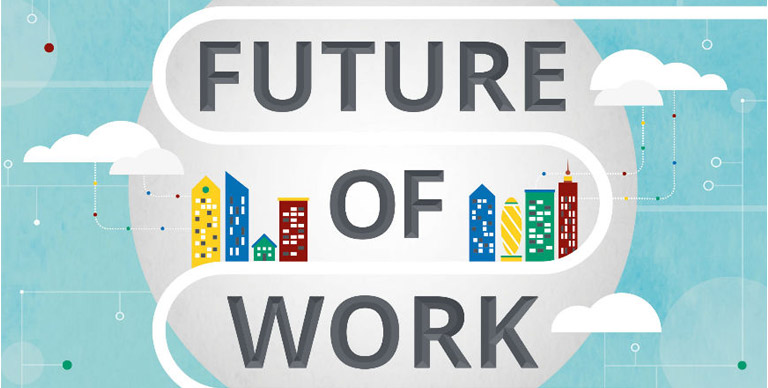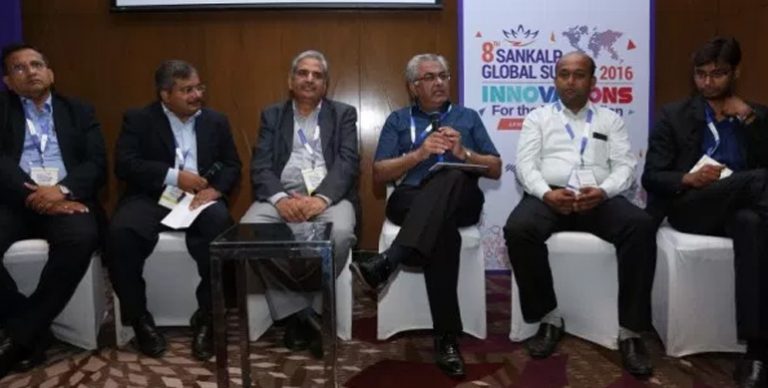India in 2050: Future of Work
Digitization and exponential technologies like the Internet of things, big data, blockchain, artificial intelligence, 3D printing, machine learning, and robotics not only disrupt the ways we design, produce, manage and maintain products and services at a fast pace, but also the way we will work in the future. IBM’s Watson technology is already complementing human decision-making in fields such as cancer diagnostics through artificial intelligence. So will Watson and Co replace human labor in 2050? Global thought leaders like Stephen Hawking are warning already that the very technology that has been an enabler for mankind in the past, has the potential to destroy the world, as increasing automation is going to decimate middle class jobs, worsening inequality and risking significant political upheaval.
While emerging technologies bring higher productivity and efficiencies, estimates already suggest that up to 45% of tasks people are paid to do every day could be automated in the future—with big impacts on emerging markets. China is acquiring 160.000 robots this year and a recent report by Citi and the Oxford Martin School shows that the Chinese market has already replaced the US as the largest market for industrial automation. In India, textile giant Raymond is planning to cut about 10,000 jobs in its manufacturing centers in the next three years, replacing them with robots. IT-Giant Infosys has already announced reducing jobs through automation. The future will see business without people, like the fast-food chain Eatsa that requires zero human interaction.
The ‘future of work’ is not only shaped by automation, but also by changing aspirations: Enabled by technology and driven by increasing entrepreneurialism, the idea of ‘employment’ is already changing: The current generation of millennials is increasingly looking for purpose and personal development. The rise of the ‘on demand’ economy gives more power to the individual: Estimates suggest that by 2020, 1 in 2 people in the US and UK will work in a freelance capacity. While routine tasks are expected to be increasingly completed by intelligent machines and technology, creativity, analytical skills and problem solving will be requirements of the job of the future.
Is the picture so gloom? Human history has shown that technology has not only improved working conditions and living standards, increased value creation and raised incomes, it also created life-changing innovations such as the steam engine, the conveyer belt, airplanes or the internet – and yet we fail to predict its implications. “The global demand for cars will not exceed 1 million, one reason being the shortage of drivers,” estimated Gottlieb Daimler in 1901. In the same year, Wilbur Wright, a pioneer in aviation, estimated: “It will not be possible for humankind in the next fifty years to take-off in a metal plane.” The rest is history. We are certain that the future of work is changing, but the effects will not only be negative. These shifts will play out differently in India – and we need to join forces to prepare and make it inclusive.
THE FUTURE OF WORK IN INDIA 2050 – Threat or opportunity?
Job creation is one of India’s biggest development challenges. Unemployment is projected to increase from 17.7 million last year to 17.8 million in 2017 and 18 million next year. The challenge is increasing with one million young Indians entering the labor market every month: The average age of an Indian in next two decades will be an average of 29 years as compared to the age of 37 years for China and 48 years for Japan. Job growth is not keeping up with this pace: According to Labor Bureau data, only 0.13 million jobs have been created in the last year, while 13 million people are added to the workforce every year. So where are the jobs? World Bank estimates that automation could replace up to 69% of jobs as we know them today in India. As per a recent survey, over 25% of employers in India expect to reduce the headcount as a result of digitization. At the same time, India 2050 will have 1.6 billion people connected to a global 9.7 bn market, opening up new opportunities for income generation and the way people engage with ‘work’. So against these trends, how does the future of work look like in India 2050?
WHAT WE DO: Complementing forces – The worker of the future leverages technology
The future will look positive for high skilled labour – but what does it look like for unskilled and semi-skillled labour? In India in 2050, many of the routine jobs will most likely be replaced by technology and cheap labor will cease to be a competitive advantage in India. Agriculture will be one of the sectors most affected by the shift, as 55% of Indians are employed in agriculture. They contribute only 16% net to the GDP, as most farmers are engaged in subsistence farming. Technology advances may change the scenario: In the short term, the farmer of the future will leverage technology to gather knowledge, increase his skills and produce closer to the market requirement, at higher prices and without losses along the value chain. In the long run, the ‘farm of the future’ will be driven by talent that leverages sensors, IoT, robotics and artificial intelligence to increase productivity and reduce cost, hence increasing competitiveness of the sector and potentially leading to another ‘green revolution’.
Similarly, the manufacturing sector will go through a transformation. While India’s share of manufacturing employment is small with just 12% of all jobs, emerging technologies such as 3D-printing, robotics, and artificial intelligence will impact the way we think about “Make it in India” and its impact on employment creation. While in the short-term, automation may replace routine and manual jobs, the factory of the future will be driven by newly skilled professionals leveraging a connected environment of technology and data insights from research and development to production processes, maintenance and repair, creating customized products and responding to shorter product life cycles. Future factories will operate hyper-efficiently: Internet of things, connectivity, artificial intelligence and analytics will create a more agile and flexible shop floor, improving asset efficiency, at the same time requiring new skills from operators. As a result, India’s manufacturing has the potential to boost productivity and hence increase competitiveness.
Likewise, India’s IT industry will experience a major shift: A report released by NASSCOM predicts that the industry will generate $350 billion revenue by 2025, but because of automation, the total number of jobs generated will be 50% less than predicted. At the same time, new type of jobs will be created: While today, the IT-sector has mostly routine-jobs, the sectorwill see a 56% increase in high-skilled jobs that require analytical and problem solving skills. Intelligent technologies will augment existing jobs and enable us to be more productive, make better decisions, produce goods and services faster and closer to the user, and create new jobs. Rather than fearing how automation, robotics and 3D Printing are replacing jobs, the potential for India lies in creating new kind of jobs that combine automation with human interaction, as machines and humans are highly complementary and make use of productivity gains.
HOW WE DO: The “Uberization of labor” and Micro Entrepreneurship 2.0
Mass employment through boosting manufacturing has not been a “silver bullet” to take Indians out of unemployment; however, emerging technologies will act an enabler for generating new employment opportunities. No one has demonstrated this better than Uber: The company’s success in developing a mobile application that allows individuals to submit a trip request to drivers who use their own cars has disrupted not only the transportation sector, but the way we think about exchanging underutilized capacity of existing assets or human resources with close to zero transaction costs.
Talent platforms like Pilot show that the next wave of the ‘on demand’ economy will give more power to the individual and disrupt the way we think about employment. Indian-startup Squadrun provides a platform for individuals to take up tasks remotely such as verifying, categorizing and enriching data for global businesses. OlaCabs, TaxiForSure or Russsh are other Indian examples leveraging ‘on demand’ and providing jobs for India’s underutilized masses and giving rise to a new kind of micro entrepreneur providing services for those who value convenience. The pool of contingent workers may soon include students, single parents, young unemployed and pensioners. According to GSMA, 1 million jobs have been created in 2016 alone by the ‘on demand’ and sharing economy.
HOW WE ORGANIZE OUR WORK: The future of work is decentralized
Enabled by technology, the future of work will strengthen decentralization of work: On the individual level, this means work and value creation can happen from anywhere. Transformation of the workplace is already happening: Remote working, co-working and teleconferencing are today’s drivers empowering the individual and providing new kind of freedom. Mobile and cloud technology allow remote and instant access, democratizing access to jobs and income opportunities. With the shifts is what and how we work in India of the 2050, the way work is organized changes: Roles within companies will change and the way business is organized will shift to more decentralized structures, empowering individuals and teams.
This trend of individuals offering their service on platforms to increase their income opportunities will boost a new form of collaborative economy and give rise to new organizational models: While traditionally, organizations were formed to reduce transaction costs, technology enable new forms of getting work done—to the extent of removing the aggregating entity, the firm, completely and allowing individuals to transact directly with each other. In a system where information can flow easily and emerging technologies can reduce the transaction costs of matching labor and requirements, the individuals can become nodes in a single marketplace and form “just in time” teams and organizations. New collaborative platforms enable a seamless integration into global labor market on one hand, while it strengthens localized market places on the other hand. Token-based payment systems will support individuals to work seamlessly with each other and receive value for their work.
HOW WE NEED TO PREPARE: The future of work is near, but will it be inclusive?
India in 2050 will see new opportunities for those ambitious to learn and engage, while providing opportunities to engage and to offer labor on new kind of market places for those engaged in routine-tasks. To prepare, the task ahead of us requires re-skilling and strengthening of current capabilities to prevent a growing gap between those who have opportunities and those who are excluded. We face the risk of rising class struggles if we don’t take action and prepare. We believe preparing for an inclusive future of work means i) massive efforts in up-skilling through innovative forms of training delivery, ii) new kinds of job discovery for those un- and semi-skilled workers, iii) re-thought incentives for automation in countries with high population like India, and iv) social security structures that support those excluded from opportunities.
-
Up-Skilling Innovations
The future labour market will reward those who are keen to learn, the problem solvers and creative. But this is not everyone: India can take advantage of new forms of learning, training and skill building to up-skill those willing to learn. Emerging technologies enable customized, and contextual training delivered through videos, text, games and other mediums, independent of centralized educational institutions such as universities. While MOOC-enabled distance education has been around, the future lies in a combination of ‘education on your fingertips’ through formats such as accessible nanodegrees in vernacular languages and more engaging virtual reality-enabled class room education enabled via mobile phones. Platforms like Udemy are already today providing new ways of ‘just-in-time’ skilling and providing trainings on core competencies. In the future, these offerings may have to be broadened to include all part of society.
-
Job Discovery & Matchmaking Innovations
The micro entrepreneurs of the future require open access platforms to offer their talent. The Facebook is already making headway and providing help to lower skilled people to find jobs. Platforms like US-based Viridis use advanced algorithmic technology to assist students and job seekers with mid-level skills to find jobs. Startups like India-based Shortlist use smart algorithms to match talent, especially young job entrants, with opportunities. Models exist in other forms of the world, like Kenya, where mobile-based platform KaziConnect is connecting informal workers with jobs and offering them the chance to skill up through training courses and mobile education, and offering certifications that can be uploaded onto their profiles. Such platforms offer particular potential to bring women from lower income groups into the workforce, who often find it more difficult to access the job market.
-
Re-thinking Incentives
While some of thinking of regulating automation, this is not the answer: Policy makers need to encourage innovation and competitiveness; however, they can incentivize the private sector to take part of the re-skilling investment. Private investment is critical to address the re-skilling task, and incentives need to be created to crowd in private capital. In addition, decrease in overall amount of number of jobs is not per se a negative thing, if coupled with other interventions: Countries are already moving to 4 day work week or 20 hour work week, and as long as the income earned pays the bills there is no problem with that. This re-structuring of work provides opportunity to give work to more people and hence counter the effects of job destruction caused by automation.
-
Protecting those at the Base of the Pyramid
We need to think of new systems to secure income for those who cannot keep up with the speed of technology: Ideas like universal basic income and tailored ways of transferring social benefits to those in need and complementing their incomes will be needed to prevent growing inequality and the rise of a two-tiered society. Innovations are needed that allow those micro entrepreneurs working in the ‘freelance’ and on demand economy to articulate their interests. With the advent of the on-demand economy, the structure and the ability of unions to fight for labor rights will be diminished, due to the latent and flexible nature of jobs. New structures will need to be thought of to empower individuals to raise their voice.
Call for Action: Towards an inclusive future
Will the future of work mean we need to be afraid of machines solving tomorrow’s problems: Not necessarily, if we take action nowt! We do not believe that machines will have replaced humans in doing everything we consider valuable: Eradicating diseases? Erasing poverty? This will be done only with the people-centric innovation economy that uses machines to provide insights at speed, customize solutions, democratize access and change existing systems to elevate the value of people and empowering them. At the same time, we need to jointly work on creating mechanisms to provide opportunities and income to those at the Base of the Pyramid and to create an inclusive futureof work.
Authors
Stefanie Bauer:
Stefanie is Associate Vice President at Intellecap. She brings over 10 years of experience in the field of Private Sector Development in Europe, Africa and Asia. At Intellecap, she is currently leading research and consulting engagements around emerging technologies and their impact for social development in emerging markets.
Samruddhi Mulye:
Samruddhi heads HR for Intellecap-Aavishkaar Group. She brings with her over 17 years of HR experience. Her proficiency being in Capacity-Building , Performance Management and Program Development for institutional transformation.








